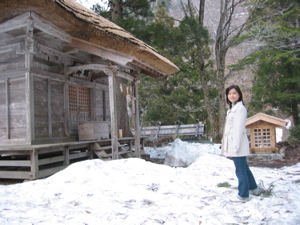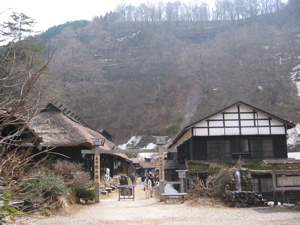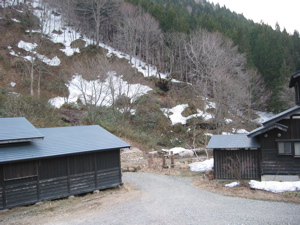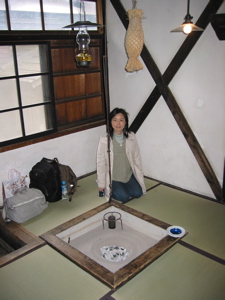
May 6th 2007
I think I'll just aim to do the next stop on our trip today, which means that there will probably be three or four more entries after this one about it. I'll try to get another one done tomorrow, but then I have to start work again, so there may be a bit of a delay before I can get the whole thing finished.
Tsuru no Yu
After Kakunodate, our next stop was three nights at Tsuru no Yu. Tsuru no Yu is an onsen, a hot springs ryokan, and it is very famous; it tends to win awards for "the best outdoor bath in northern Japan" and similar. We really liked it.
The first step, however, was getting there. First, we took the shinkansen one stop from Kakunodate to Tazawako. From the station in Tazawako, we got a standard bus, after calling the ryokan to let them know which one we would be on. That bus wound its way up into the mountains for half an hour, and we got off at a place with a large car park. It's not the nearest stop to the ryokan, but it's not far, and because of the car park the onsen staff can wait there, in the minibus, relatively easily. We then got on the minibus, and drove off to the onsen. This was another tweny minutes or so. After turning off the "main" road (it was small) onto the road that goes nowhere but the onsen, there were still about three kilometres to go.
 Yuriko outside Tsuru no Yu Shrine.
Yuriko outside Tsuru no Yu Shrine.
The ryokan is, pretty much literally, miles from anywhere. The nearest other building is the ryokan's own "bekkan", or separate building, and that's one and a half kilometres down the entrance roadway. It's outside the range of cell phones, and I suspect that the reason that none of the rooms have televisions is partly because it's outside the range of television signals, too. It's up in the mountains, so there was still a lot of snow on the ground. Obviously, the areas around the ryokan itself were partially cleared, but the walking trails were still largely closed due to snow. In fact, on the first evening we went for a walk around the ryokan, and walked up to a small shrine, which is on a very small hill at the entrance to the ryokan. As you can see from the picture, there was still a lot of snow on the ground there.
 Tsuru no Yu onsen. We stayed in the building on the right.
Tsuru no Yu onsen. We stayed in the building on the right.
The buildings of the ryokan are all wooden, and the main building is thatched, as you can see on the picture. There are actually several buildings scattered around, most of which are guest accommodation. The thatched building on the left of the picture is the main building, which includes reception, several guest rooms, and the rooms where we ate. The building on the right is where we stayed; it contains quite a lot of guest rooms. There are two more buildings of accommodation behind the main building, and service buildings behind the one we were in. The hot springs are at the end of the path between the buildings, across a river. Although you can't see it in the picture, there's a water wheel in front of the building on the right (just out of shot).
 The view from our window at Tsuru no Yu. The visible buildings are service buildings.
The view from our window at Tsuru no Yu. The visible buildings are service buildings.
The main reason for going to Tsuru no Yu is the hot springs. There are four, all different, although one of them is closed in winter; I'm not sure why, but it may be to do with the temperature of the water. The name of the springs means "Hot Water of the Crane". The story is that someone, about a thousand years ago, saw a crane bathings its injuries in the hot water, and thus the springs were discovered. They have been popular for quite a while, and the ryokan has been there for decades, at least. As it is popular, reservations can be a bit difficult to get. I phoned six months in advance, and there were already only rooms left in one building, despite the fact that reservations only open, in general, six months in advance. (From things people said, I'm not sure that that is absolute.) Our room was simple; six tatami mats, and shared toilets and washing areas. Still, it was nice, and, as Yuriko commented, one of the nice things was that the toilets were very clean.
But on to the hot springs. Japanese people really like them, and, finally, I understand why. I don't think I'll ever be as big a fan as some Japanese are, but these were very good; very relaxing. The four different springs all feed different baths. There are the White Spring, the Black Spring, the Middle Spring, and the Waterfall Spring. The Waterfall Spring is the one that doesn't run in winter. There are indoor baths for the first three springs, which are separate for men and women, and there is also an outdoor bath that is only for women. However, the biggest and best bath is an outdoor one for both sexes.
There was no way we could go to Tsuru no Yu and not try that bath, but Yuriko had never been to a mixed bath either, so we weren't quite sure what to do. So, we asked. The man in the office told us where the changing rooms were (they are separate for men and women even for the mixed bath), and explained that, while some people wear bath towels in the mixed bath, many don't, and there's really no need. It's called the White Spring because the water is white, and really not transparent at all. If you're immersed in it, only someone right next to you would be able to see anything. (You don't wear swimsuits. You never wear swimsuits in a Japanese hot spring.)
We decided to do without bath towels, partly out of concern for how we would dry ourselves if we wore our towels into the bath. (By the last day, we had a total of six bath towels, so that was no longer a problem.) When we got there, I realised that it was pointless me worrying; the men's changing room is all glass walls, and right by the side of the bath. If you're bothered about people, including women, seeing you naked, this is not the place to go. In general, men don't bother with bath towels (so if you object to seeing naked men, this is also not the place to go), and women seem to be about fifty/fifty. It's a bit difficult to be sure, because you can't actually tell whether someone has a towel wrapped round them while they're in the water.
Anyway, the bath was great. The water temperature was really pleasant, and because the bath is very big, you can adjust the temperature by moving towards or away from the spring. I found a perfect spot, where the rocks around the edge form a seat that leaves me in the water about up to my navel. Thus, the upper part of my body can cool down, while the lower part is warm. On average, then, I feel fine. Note: this actually works, thanks to the circulation of the blood. By the second day, I'd worked out that I should take a bottle of water with me, because sitting in hot water dehydrates you.
The baths are open twenty four hours, so we went in the morning before breakfast, and in the evening after dinner. Our first full day was clear, so we got to see the stars and the full moon from the bath; that was very romantic. There also weren't as many people in it as you might expect. Although the baths are open to day-trippers from 10 to 3, they are only for residents outside that time, and there is a limit to how long you can stay in the water without a break. Thus, I got the bath to myself on a few occasions, which was really nice.
Yuriko didn't go with me on a few occasions, partly because pregnant women need to moderate the time they spend in hot springs, and partly because she wasn't very well on the second day, and spent most of the day asleep in our room. I spent most of the time in there with her, reading, but I did go to the bath in the evening. That day, it rained a lot, so staying in was a good choice. The outdoor bath in the rain was interesting; the cold rain helped cool me down.
 One of the hearths in the dining rooms. We ate here a couple of times.
One of the hearths in the dining rooms. We ate here a couple of times.
Apart from the baths, there was also the food. The food was great, but very Japanese. We had a different menu every night, and as we ate in the main building, we could see what other people have. As is normal at ryokan, you don't get a choice, and it looks like they have a "first night menu", a "second night menu", and so on. We got up to three, but I don't know how long the sequence would continue. The meals were all served on "o-zen", which are like trays with legs. You sit on the tatami to eat, so it's a good job that I've got more used to it.
The dining rooms have open hearths that burn charcoal, and they are in use at mealtimes. One of the things they are used for is cooking part of the meal. Every meal included a "nabe", Japanese stew, and the ryokan's famous "mountain potato stew" was kept in pots hanging over the hearth. Every evening meal also included fish-on-a-stick. This is a whole river fish, gutted, speared on a stick, and grilled. You eat it by picking up the stick and biting bits off, skin, bones, and all. A bit like an ice lolly. Except hot. And fishy. And with bones. So not really much like an ice lolly at all, now that I think about it. You don't generally eat the head and tail, although I think you can, and I never managed to eat the whole thing. Mind you, that was as much because of the amount of food on offer as because of the "It's still very obviously a fish" thing.
Breakfast was also Japanese style, with more whole fish, and natto. On the second morning, I happened to mention to the server that I didn't like natto, and on the third morning I had a Japanese-style salad as a substitute. Indeed, the attitude of the staff was generally very good; very friendly. It was also surprisingly cheap. Because we were staying for three nights, we qualified to get free lunches, and a discount on the basic room rate. That meant that, including three meals, it was just under 7,000 yen each per night.
I want to go back, with Yuriko and Yudetamago. Yuriko wants to take her parents along, too. I think it's probably a bit too Japanese for my parents to really enjoy themselves, although Mum and Ray would love the surrounding area. We also want to go at different seasons, so that we can do the walks, and see it in the snow. Oh, and stay in the main building, with the thatched roof. On the evening of the second full day I was chatting to a lady in the bath (as you do...), and she was saying that, in Japan, it's worth becoming a regular somewhere. We've already seen that at Sawanoya, where we had a lion dance performed for us because I was a regular. I think I'd quite like to become a regular at Tsuru no Yu. And that's actually an affordable ambition.